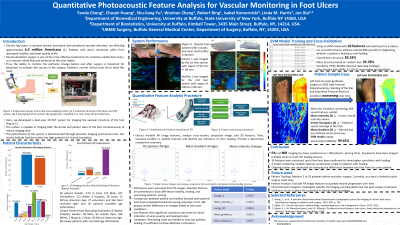Clinical Research
(CR-013) Wound Healing and Tissue Perfusion Assessed by Photoacoustic Imaging

Introduction: Tissue perfusion plays a major role in wound healing. Existing techniques fail to provide detailed visualization of perfusion. In this study, we developed a photoacoustic imaging (PAI) system capable of mapping vascular structures in the foot. The system was validated in healthy subjects and patients to identify vascular features of tissue perfusion.
Methods:
Methods: The system was developed based on the photoacoustic principle, where hemoglobin molecules in tissue and blood vessels absorb short pulsed light and generate acoustic signals that can be detected by ultrasound transducers. By scanning the transducer across the foot, we acquired high-resolution, three-dimensional images of the foot vasculature. After validating the system's performance in healthy volunteers, we further tested it in patients recruited from the vascular surgery clinic. Statistical and machine learning processes were performed to identify key features of tissue perfusion and wound healing.
Results:
Results: We quantified the system's performance through phantom and in vivo tests. The spatial resolution ranged from 0.8 to 1.2 mm along the three dimensions, and the imaging depth was around 15 mm. We then analyzed data from 20 patients and 10 healthy volunteers and extracted 39 PAI features. By ranking these features with clinical observation, we found that vessel sharpness, occupancy, intensity, density, SNR, and signal homogeneity have a high correlation with tissue perfusion and wound severity. Statistical analysis of the data further validated these features as robust indicators.
Discussion:
Discussion: This study highlights the clinical potential of photoacoustic imaging for assessing foot ulcer and wound healing. Its non-invasive nature ensures easy integration into clinical workflows. While current findings are limited by the patient dataset size, future studies with larger populations will further validate the results and pave the way for clinical translation. Advancements in machine learning will further enhance PAI’s clinical utility, making it a promising tool for wound care.

.jpg)